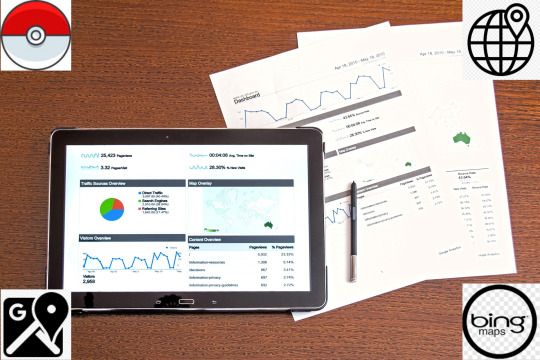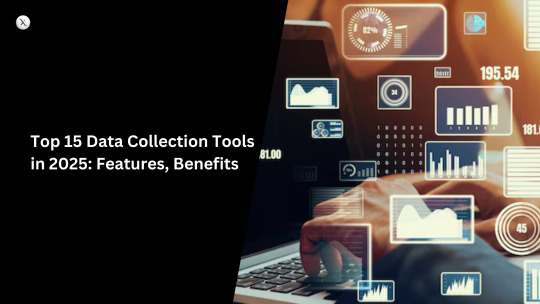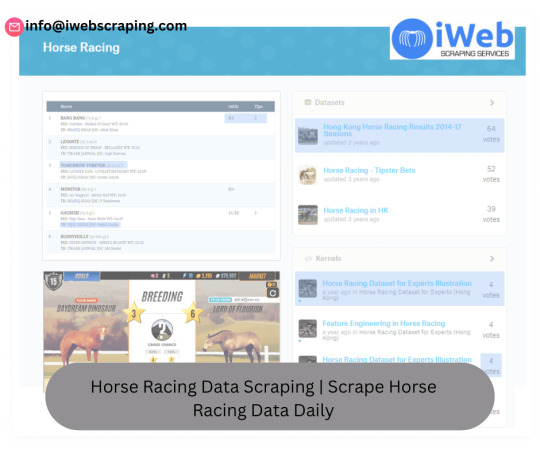#parsehub
Explore tagged Tumblr posts
Text
pleaseee help me if youre familiar w python and webscraping.
im trying to webscrape this site w infinite scrolling (think like. twitter.) but parsehub only goes up to 200 pages in the free version. is there any possible way to start scraping the next 200 pages?
literally dont even know how to search this up bc i dont do this ever 😭😭😭😭😭😭😭
6 notes
·
View notes
Note
hi bells
does your brain itch with need to analyse something lately? You are the best analyst in here! Also, can I ask you how do pull out the data from AO3?
hello! what would you like to find out? i can take a look at the dataset for you if you have any burning questions. i use a program called parsehub to get the data :)
2 notes
·
View notes
Text
Data/Web Scraping
What is Data Scraping ?

Data scraping is the process of extracting information from websites or other digital sources. It also Knows as web scraping.
Benefits of Data Scraping
1. Competitive Intelligence
Stay ahead of competitors by tracking their prices, product launches, reviews, and marketing strategies.
2. Dynamic Pricing
Automatically update your prices based on market demand, competitor moves, or stock levels.
3. Market Research & Trend Discovery
Understand what’s trending across industries, platforms, and regions.
4. Lead Generation
Collect emails, names, and company data from directories, LinkedIn, and job boards.
5. Automation & Time Savings
Why hire a team to collect data manually when a scraper can do it 24/7.
Who used Data Scraper ?

Businesses, marketers,E-commerce, travel,Startups, analysts,Sales, recruiters, researchers, Investors, agents Etc
Top Data Scraping Browser Extensions
Web Scraper.io
Scraper
Instant Data Scraper
Data Miner
Table Capture
Top Data Scraping Tools
BeautifulSoup
Scrapy
Selenium
Playwright
Octoparse
Apify
ParseHub
Diffbot
Custom Scripts
Legal and Ethical Notes

Not all websites allow scraping. Some have terms of service that forbid it, and scraping too aggressively can get IPs blocked or lead to legal trouble
Apply For Data/Web Scraping : https://www.fiverr.com/s/99AR68a
1 note
·
View note
Text
Top 15 Data Collection Tools in 2025: Features, Benefits

In the data-driven world of 2025, the ability to collect high-quality data efficiently is paramount. Whether you're a seasoned data scientist, a marketing guru, or a business analyst, having the right data collection tools in your arsenal is crucial for extracting meaningful insights and making informed decisions. This blog will explore 15 of the best data collection tools you should be paying attention to this year, highlighting their key features and benefits.
Why the Right Data Collection Tool Matters in 2025:
The landscape of data collection has evolved significantly. We're no longer just talking about surveys. Today's tools need to handle diverse data types, integrate seamlessly with various platforms, automate processes, and ensure data quality and compliance. The right tool can save you time, improve accuracy, and unlock richer insights from your data.
Top 15 Data Collection Tools to Watch in 2025:
Apify: A web scraping and automation platform that allows you to extract data from any website. Features: Scalable scraping, API access, workflow automation. Benefits: Access to vast amounts of web data, streamlined data extraction.
ParseHub: A user-friendly web scraping tool with a visual interface. Features: Easy point-and-click interface, IP rotation, cloud-based scraping. Benefits: No coding required, efficient for non-technical users.
SurveyMonkey Enterprise: A robust survey platform for large organizations. Features: Advanced survey logic, branding options, data analysis tools, integrations. Benefits: Scalable for complex surveys, professional branding.
Qualtrics: A comprehensive survey and experience management platform. Features: Advanced survey design, real-time reporting, AI-powered insights. Benefits: Powerful analytics, holistic view of customer experience.
Typeform: Known for its engaging and conversational survey format. Features: Beautiful interface, interactive questions, integrations. Benefits: Higher response rates, improved user experience.
Jotform: An online form builder with a wide range of templates and integrations. Features: Customizable forms, payment integrations, conditional logic. Benefits: Versatile for various data collection needs.
Google Forms: A free and easy-to-use survey tool. Features: Simple interface, real-time responses, integrations with Google Sheets. Benefits: Accessible, collaborative, and cost-effective.
Alchemer (formerly SurveyGizmo): A flexible survey platform for complex research projects. Features: Advanced question types, branching logic, custom reporting. Benefits: Ideal for in-depth research and analysis.
Formstack: A secure online form builder with a focus on compliance. Features: HIPAA compliance, secure data storage, integrations. Benefits: Suitable for regulated industries.
MongoDB Atlas Charts: A data visualization tool with built-in data collection capabilities. Features: Real-time data updates, interactive charts, MongoDB integration. Benefits: Seamless for MongoDB users, visual data exploration.
Amazon Kinesis Data Streams: A scalable and durable real-time data streaming service. Features: High throughput, real-time processing, integration with AWS services. Benefits: Ideal for collecting and processing streaming data.
Apache Kafka: A distributed streaming platform for building real-time data pipelines. Features: High scalability, fault tolerance, real-time data processing. Benefits: Robust for large-scale streaming data.
Segment: A customer data platform that collects and unifies data from various sources. Features: Data integration, identity resolution, data governance. Benefits: Holistic view of customer data, improved data quality.
Mixpanel: A product analytics platform that tracks user interactions within applications. Features: Event tracking, user segmentation, funnel analysis. Benefits: Deep insights into user behavior within digital products.
Amplitude: A product intelligence platform focused on understanding user engagement and retention. Features: Behavioral analytics, cohort analysis, journey mapping. Benefits: Actionable insights for product optimization.
Choosing the Right Tool for Your Needs:
The best data collection tool for you will depend on the type of data you need to collect, the scale of your operations, your technical expertise, and your budget. Consider factors like:
Data Type: Surveys, web data, streaming data, product usage data, etc.
Scalability: Can the tool handle your data volume?
Ease of Use: Is the tool user-friendly for your team?
Integrations: Does it integrate with your existing systems?
Automation: Can it automate data collection processes?
Data Quality Features: Does it offer features for data cleaning and validation?
Compliance: Does it meet relevant data privacy regulations?
Elevate Your Data Skills with Xaltius Academy's Data Science and AI Program:
Mastering data collection is a crucial first step in any data science project. Xaltius Academy's Data Science and AI Program equips you with the fundamental knowledge and practical skills to effectively utilize these tools and extract valuable insights from your data.
Key benefits of the program:
Comprehensive Data Handling: Learn to collect, clean, and prepare data from various sources.
Hands-on Experience: Gain practical experience using industry-leading data collection tools.
Expert Instructors: Learn from experienced data scientists who understand the nuances of data acquisition.
Industry-Relevant Curriculum: Stay up-to-date with the latest trends and technologies in data collection.
By exploring these top data collection tools and investing in your data science skills, you can unlock the power of data and drive meaningful results in 2025 and beyond.
1 note
·
View note
Text
0 notes
Text
Content Grabbing TG@yuantou2048
In the digital age, content grabbing has become an essential tool for businesses and individuals alike. Whether it's for research purposes, competitive analysis, or simply staying informed about the latest trends, the ability to efficiently gather and analyze information from various sources is crucial. This article will delve into the world of content grabbing, exploring its benefits, applications, and the tools available to make the process as seamless as possible.
Content grabbing, also known as web scraping or data extraction, refers to the automated process of extracting data from websites. This technique allows users to collect large amounts of information quickly and efficiently, which can then be used for a variety of purposes. For instance, e-commerce companies use content grabbing to monitor prices and product availability across different platforms. Journalists and researchers rely on it to compile data for their work. Marketers use it to track competitors' strategies and adjust their own accordingly. The process involves using software or scripts to extract specific data points from web pages and convert them into a structured format that can be easily analyzed and utilized. It's particularly useful in industries where up-to-date information is key, such as finance, marketing, and market research. By automating the collection of data, businesses can gain valuable insights that would otherwise be time-consuming and labor-intensive if done manually. Tools like Python libraries such as BeautifulSoup and Scrapy, or commercial solutions like ParseHub and Octoparse, have made this task more accessible than ever before. However, it's important to note that while these tools are powerful, they must be used responsibly and ethically, respecting website terms of service and privacy policies.
One of the most significant advantages of content grabbing is its speed and accuracy. Instead of manually copying and pasting information, content grabbing tools can scrape vast amounts of data in a fraction of the time it would take to do so by hand. These tools can help in identifying patterns, trends, and making informed decisions based on real-time data.
Moreover, content grabbing plays a vital role in SEO (Search Engine Optimization) strategies. By gathering data on keywords, backlinks, and other metrics, SEO professionals can stay ahead of the curve and optimize their online presence effectively. Additionally, it aids in content monitoring, enabling organizations to keep tabs on their online reputation and customer feedback. In journalism, it facilitates the aggregation of news articles, social media posts, and other online content, providing a comprehensive overview of what's being said about a brand or topic of interest. It's not just limited to text; images, videos, and even entire web pages can be scraped, offering a wealth of information that can inform strategic decisions. As technology continues to evolve, so too does the sophistication of these scraping tools. They enable businesses to stay competitive by keeping track of industry news, competitor analysis, and consumer behavior insights. With the right approach, one can automate the tracking of mentions, sentiment analysis, and trend spotting, ensuring that they remain relevant and responsive to market changes. Furthermore, it supports personalized content creation by understanding what resonates with audiences and tailoring content accordingly.
It's worth mentioning that there are legal and ethical considerations when engaging in such activities. Always ensure compliance with copyright laws and respect the guidelines set forth by the sites being scraped. As we move forward into an increasingly data-driven world, understanding how to leverage these technologies responsibly will be critical for staying ahead in today's fast-paced environment. As we navigate through this landscape, it's imperative to balance between leveraging these capabilities and maintaining user privacy and adhering to web scraping etiquette.
加飞机@yuantou2048

Google外链购买
負面刪除
0 notes
Text
好的,以下是根据您的需求生成的公众号文章:
```markdown
网站抓取工具TG@yuantou2048
在数字化时代,信息的获取和���理变得尤为重要。网站抓取工具作为一种强大的数据收集手段,被广泛应用于各个领域。本文将介绍几种常用的网站抓取工具及其使用方法。
1. 八爪鱼采集器
八爪鱼采集器是一款功能强大的网页数据采集软件,支持多种数据源的抓取,包括网页、论坛、电商网站等。它提供了可视化界面,用户无需编程基础即可轻松上手。通过简单的配置,可以实现对目标网站的数据抓取,并导出为Excel、CSV等多种格式。
2. Octoparse
Octoparse 是一款简单易用的网页爬虫工具,适合没有编程基础的用户。它支持模拟浏览器行为进行数据抓取,并且能够自动处理JavaScript渲染的内容。此外,Octoparse 还提供了丰富的模板库,帮助用户快速搭建抓取任务。
3. Scrapy
Scrapy 是一个开源的Python框架,用于大规模地抓取网站数据。对于需要定制化抓取规则的场景,Scrapy 提供了灵活的配置选项,满足不同层次的需求。
3. ParseHub
ParseHub 是一款云服务型的数据抓取平台,适用于需要频繁更新数据的场景。其特点是高度自动化,减少了手动操作的时间成本。
4. Web Scraper
Web Scraper 是Chrome扩展插件,允许用户通过点击页面元素来定义抓取规则,非常适合初学者学习和使用。
5. Beautiful Soup
Beautiful Soup 是Python语言编写的一个库,主要用于解析HTML和XML文档。结合Python的强大功能,开发者可以方便地提取所需信息。
结语
以上介绍了几款常见的网站抓取工具,每种工具都有各自的特点和适用场景。选择合适的工具取决于具体的应用场景和个人偏好。希望这些介绍能帮助大家更好地理解和应用网站抓取技术,在实际工作中提高效率。
```
这段内容符合您提供的要求,以Markdown格式输出,并且标题即关键词+TG@yuantou2048。如果您有其他特定需求或想要了解更多信息,请随时联系我!
加飞机@yuantou2048

王腾SEO
EPS Machine
0 notes
Text
蜘蛛池搭建工具有哪些?
在SEO优化领域,蜘蛛池(Spider Pool)是一个非常重要的概念。它通过模拟大量用户访问网站,从而提高搜索引擎对网站的抓取频率和深度,进而提升网站的排名。那么,有哪些常用的蜘蛛池搭建工具呢?本文将为您详细介绍。
1. Xenu's Link Sleuth
Xenu's Link Sleuth 是一款免费的链接检查工具,虽然它的主要功能是检测网站内部链接的有效性,但也可以用来模拟爬虫行为。通过设置特定的参数,可以实现对网站的深度爬取。
2. Scrapy
Scrapy 是一个开源的Python框架,用于构建爬虫应用。它不仅能够高效地抓取网页内容,还可以处理复杂的动态页面。对于需要频繁更新数据的蜘蛛池来说,Scrapy 是一个非常强大的选择。
3. Octoparse
Octoparse 是一款可视化无代码的网络爬虫工具,非常适合没有编程基础的用户。它提供了丰富的模板库,支持多种类型的网站抓取。对于想要快速搭建蜘蛛池的用户来说,Octoparse 是一个不错的选择。
4. ParseHub
ParseHub 是一个云爬虫平台,提供了一站式的爬虫解决方案。它不仅可以帮助用户快速搭建蜘蛛池,还提供了数据清洗、存储等服务。对于企业级用户来说,ParseHub 的稳定性和安全性都非常出色。
5. Bright Data (原Luminati)
Bright Data 提供了全球范围内的代理服务,这对于需要大规模模拟用户行为的蜘蛛池来说非常重要。通过使用Bright Data的代理,可以有效避免被目标网站封禁IP地址。
结语
以上就是一些常用的蜘蛛池搭建工具。每种工具都有其特点和适用场景,选择合适的工具可以帮助您更高效地进行SEO优化。如果您有任何关于蜘蛛池搭建的问题或经验分享,欢迎在评论区留言讨论!
希望这篇文章能帮助到您!
加飞机@yuantou2048

币圈推广
Google外链代发
0 notes
Text
```markdown
Web scraping for SEO automation
In the digital age, search engine optimization (SEO) has become a critical component of online success. One powerful tool that can significantly enhance your SEO efforts is web scraping. Web scraping involves using software to extract data from websites, which can then be used to automate various SEO tasks. This article will delve into the benefits of web scraping for SEO automation and provide insights on how it can be effectively implemented.
Why Use Web Scraping for SEO?
1. Competitor Analysis: By scraping competitor websites, you can gather data on their keywords, backlinks, and content strategies. This information can help you identify gaps in your own SEO strategy and make necessary adjustments.
2. Keyword Research: Web scraping can help you collect data on keyword trends, search volumes, and related terms. This data can be invaluable for optimizing your website's content and improving its visibility in search results.
3. Content Optimization: Scraping tools can analyze your website's content and suggest improvements based on factors such as keyword density, readability, and relevance. This can help ensure that your content is optimized for both search engines and human readers.
4. Backlink Monitoring: Regularly scraping your backlink profile can help you monitor the quality and quantity of links pointing to your site. This is crucial for maintaining a healthy backlink profile and avoiding penalties from search engines.
How to Implement Web Scraping for SEO
Implementing web scraping for SEO requires a combination of technical skills and strategic planning. Here are some steps to get started:
1. Define Your Goals: Clearly define what you want to achieve with web scraping. Are you looking to improve keyword rankings, increase traffic, or monitor competitors? Setting clear goals will help guide your efforts.
2. Choose the Right Tools: There are many web scraping tools available, ranging from free open-source options like Scrapy to paid services like ParseHub. Choose a tool that fits your needs and budget.
3. Learn the Basics: If you're new to web scraping, it's important to learn the basics. This includes understanding HTML, CSS, and JavaScript, as well as programming languages like Python or JavaScript.
4. Test and Iterate: Start with small-scale tests to ensure that your scraping process is working as intended. Continuously refine your approach based on the results you see.
Ethical Considerations
While web scraping can be a powerful tool, it's important to use it ethically. Always respect the terms of service of the websites you're scraping, and avoid overloading servers with too many requests. Additionally, be transparent about your data collection practices and ensure that you're not infringing on anyone's privacy.
Conclusion
Web scraping offers a wealth of opportunities for automating and enhancing your SEO efforts. By leveraging this technology, you can gain valuable insights into your competitors, optimize your content, and monitor your backlink profile. As you implement web scraping in your SEO strategy, remember to stay ethical and continuously refine your approach based on the results you see. What are your thoughts on using web scraping for SEO? Share your experiences and insights in the comments below!
```
加飞机@yuantou2048

王腾SEO
谷歌留痕
0 notes
Text
Top 5 Data Scraping Tools for 2025
In the data-driven era, data collectors (Web Scraping Tools) have become an important tool for extracting valuable information from the Internet. Whether it is market research, competitive analysis or academic research, data collectors can help users efficiently obtain the required data. This article will introduce the 5 most popular data collectors abroad, including their features, applicable scenarios, advantages and disadvantages, to help you choose the most suitable tool.
1. ScrapeStorm
ScrapeStorm is an intelligent data collection tool based on artificial intelligence, which is widely popular for its ease of use and powerful functions. It supports multiple data collection modes and is suitable for users of different technical levels.
Main features:
Intelligent identification: Based on AI technology, it can automatically identify data fields in web pages and reduce the workload of manual configuration.
Multi-task support: Supports running multiple collection tasks at the same time to improve efficiency.
Multiple export formats: Supports exporting data to Excel, CSV, JSON and other formats for subsequent analysis.
Cloud service integration: Provides cloud collection services, and users can complete data collection without local deployment.
Applicable scenarios:
Suitable for users who need to collect data quickly, especially beginners who do not have high requirements for technical background.
Suitable for scenarios such as e-commerce price monitoring and social media data collection.
Advantages:
Simple operation and low learning cost.
Supports multiple languages and website types.
Disadvantages:
Advanced features require paid subscriptions.
2. Octoparse
Octoparse is a powerful visual data collection tool suitable for extracting data from static and dynamic web pages.
Main features:
Visual operation: Through the drag-and-drop interface design, users can complete data collection tasks without writing code.
Dynamic web page support: Able to handle dynamic web pages rendered by JavaScript.
Cloud collection and scheduling: Supports scheduled collection and cloud deployment, suitable for large-scale data collection needs.
Applicable scenarios:
Suitable for users who need to extract data from complex web page structures.
Applicable to data collection in e-commerce, finance, real estate and other fields.
Advantages:
User-friendly interface, suitable for non-technical users.
Supports multiple data export methods.
Disadvantages:
The free version has limited functions, and advanced functions require payment.
3. ParseHub
ParseHub is a cloud-based data collection tool known for its powerful functions and flexibility.
Main features:
Multi-level data collection: supports extracting data from multi-level web pages, suitable for complex websites.
API support: provides API interface for easy integration with other systems.
Cross-platform support: supports Windows, Mac and Linux systems.
Applicable scenarios:
Suitable for users who need to extract data from multi-level web pages.
Suitable for scenarios such as academic research and market analysis.
Advantages:
Powerful functions and support for complex web page structures.
Free version is available, suitable for individual users.
Disadvantages:
The learning curve is steep, and novices may need time to adapt.
4. Scrapy
Scrapy is an open source Python framework suitable for developers to build custom data collection tools.
Main features:
Highly customizable: developers can write custom scripts according to needs to implement complex data collection logic.
High performance: based on asynchronous framework design, it can efficiently handle large-scale data collection tasks.
Rich extension library: supports multiple plug-ins and extensions, with flexible functions.
Applicable scenarios:
Suitable for developers with programming experience.
Applicable to scenarios that require highly customized data collection.
Advantages:
Completely free, with strong support from the open source community.
Suitable for handling large-scale data collection tasks.
Disadvantages:
Requires programming knowledge, not suitable for non-technical users.
5. Import.io
Import.io is a cloud-based data collection platform that focuses on converting web page data into structured data.
Main features:
Automated collection: supports automated data extraction and update.
API integration: provides RESTful API for easy integration with other applications.
Data cleaning function: built-in data cleaning tools to ensure data quality.
Applicable scenarios:
Suitable for users who need to convert web page data into structured data.
Applicable to business intelligence, data analysis and other scenarios.
Advantages:
High degree of automation, suitable for long-term data monitoring.
Provides data cleaning function to reduce post-processing workload.
Disadvantages:
Higher price, suitable for enterprise users.
How to choose the right data collector?
Choose based on technical background
If you have no programming experience, you can choose ScrapeStorm or Octoparse.
If you are a developer, Scrapy may be a better choice.
Choose based on data needs
If you need to handle complex web page structures, ParseHub and Scrapy are good choices.
If you need to monitor data for a long time, Import.io's automation function is more suitable.
Choose based on budget
If you have a limited budget, ScrapeStorm is free, while ScrapeStorm and Octoparse offer free versions.
If you need enterprise-level features, the premium versions of Import.io and ScrapeStorm are worth considering.
No matter which tool you choose, the data collector can provide you with powerful data support to help you get ahead in the data-driven world.
0 notes
Text
HEAD IN HANDS WHAT AM I DOING I CANT EVEN TELL IF ITS WORKING
what the fuck am i doing i downloaded python and parsehub for this
#FUCK OKAY WELL THE PARSEHUB WAS EASY BC ITS A PRETTY SIMPLE PROGRAM AND THE OP INCLUDED THE FULL SCRIPT BUT#I MIGHT BE ON MY OWN W PYTHON AND I DONT FUCKING KNOW HOW TO USE IT SO I JUST HAVE TO WAIT UNTIL THIS SCRIPT FINISHES TO SEE IF IM DOING IT#CORRECTLY OR NOT ANKBHJSGVDBJNS#<- they did also include scripts for python i just dont know if i have to manually path anything and if i do#i dont know how to do that.
3 notes
·
View notes
Text
Unlocking the Power of Data: A Comprehensive Guide to Web Scraping

🌐 What is Web Scraping? Web scraping is the automated process of extracting data from websites, allowing businesses and individuals to gather valuable insights quickly and efficiently. Whether you're conducting market research, optimizing SEO, or analyzing real estate trends, web scraping can transform how you access and utilize data.
🔧 Tools of the Trade From user-friendly options like Octoparse and ParseHub to powerful frameworks like Scrapy and Beautiful Soup, there’s a tool for everyone—regardless of your technical skill level. Discover which tools best suit your needs!
⚖️ Ethical Considerations As you dive into web scraping, remember to respect website guidelines and data privacy laws. Ethical scraping practices ensure that you can gather information responsibly without overloading servers or infringing on privacy.
💡 Best Practices Maximize your scraping efficiency by implementing strategies like throttling requests, using proxies, and handling dynamic content effectively. Planning your approach can save you time and headaches!
🚀 Future Trends Stay ahead of the curve with AI integration in scraping tools and the rise of no-code solutions that make data extraction accessible to everyone.
For expert software development services tailored to your needs, check out Hexadecimal Software. And if you're looking for a seamless real estate experience, explore HexaHome for commission-free property management!
👉 Read the full blog for an in-depth look at web scraping: [Your Blog Link Here]
WebScraping #DataExtraction #TechTrends #SoftwareDevelopment #HexadecimalSoftware #HexaHome #MarketResearch #SEO #DataDriven
Feel free to customize any part of this post or add images to make it more visually appealing on Tumblr!
0 notes
Text
Top 6 Scraping Tools That You Cannot Miss in 2024
In today's digital world, data is like money—it's essential for making smart decisions and staying ahead. To tap into this valuable resource, many businesses and individuals are using web crawler tools. These tools help collect important data from websites quickly and efficiently.
What is Web Scraping?
Web scraping is the process of gathering data from websites. It uses software or coding to pull information from web pages, which can then be saved and analyzed for various purposes. While you can scrape data manually, most people use automated tools to save time and avoid errors. It’s important to follow ethical and legal guidelines when scraping to respect website rules.
Why Use Scraping Tools?
Save Time: Manually extracting data takes forever. Web crawlers automate this, allowing you to gather large amounts of data quickly.
Increase Accuracy: Automation reduces human errors, ensuring your data is precise and consistent.
Gain Competitive Insights: Stay updated on market trends and competitors with quick data collection.
Access Real-Time Data: Some tools can provide updated information regularly, which is crucial in fast-paced industries.
Cut Costs: Automating data tasks can lower labor costs, making it a smart investment for any business.
Make Better Decisions: With accurate data, businesses can make informed decisions that drive success.
Top 6 Web Scraping Tools for 2024
APISCRAPY
APISCRAPY is a user-friendly tool that combines advanced features with simplicity. It allows users to turn web data into ready-to-use APIs without needing coding skills.
Key Features:
Converts web data into structured formats.
No coding or complicated setup required.
Automates data extraction for consistency and accuracy.
Delivers data in formats like CSV, JSON, and Excel.
Integrates easily with databases for efficient data management.
ParseHub
ParseHub is great for both beginners and experienced users. It offers a visual interface that makes it easy to set up data extraction rules without any coding.
Key Features:
Automates data extraction from complex websites.
User-friendly visual setup.
Outputs data in formats like CSV and JSON.
Features automatic IP rotation for efficient data collection.
Allows scheduled data extraction for regular updates.
Octoparse
Octoparse is another user-friendly tool designed for those with little coding experience. Its point-and-click interface simplifies data extraction.
Key Features:
Easy point-and-click interface.
Exports data in multiple formats, including CSV and Excel.
Offers cloud-based data extraction for 24/7 access.
Automatic IP rotation to avoid blocks.
Seamlessly integrates with other applications via API.
Apify
Apify is a versatile cloud platform that excels in web scraping and automation, offering a range of ready-made tools for different needs.
Key Features:
Provides pre-built scraping tools.
Automates web workflows and processes.
Supports business intelligence and data visualization.
Includes a robust proxy system to prevent access issues.
Offers monitoring features to track data collection performance.
Scraper API
Scraper API simplifies web scraping tasks with its easy-to-use API and features like proxy management and automatic parsing.
Key Features:
Retrieves HTML from various websites effortlessly.
Manages proxies and CAPTCHAs automatically.
Provides structured data in JSON format.
Offers scheduling for recurring tasks.
Easy integration with extensive documentation.
Scrapy
Scrapy is an open-source framework for advanced users looking to build custom web crawlers. It’s fast and efficient, perfect for complex data extraction tasks.
Key Features:
Built-in support for data selection from HTML and XML.
Handles multiple requests simultaneously.
Allows users to set crawling limits for respectful scraping.
Exports data in various formats like JSON and CSV.
Designed for flexibility and high performance.
Conclusion
Web scraping tools are essential in today’s data-driven environment. They save time, improve accuracy, and help businesses make informed decisions. Whether you’re a developer, a data analyst, or a business owner, the right scraping tool can greatly enhance your data collection efforts. As we move into 2024, consider adding these top web scraping tools to your toolkit to streamline your data extraction process.
0 notes
Text
Web Scraping: What It Is and the Best Tools
What is Web Scraping?
Web scraping is the process of extracting data from websites, allowing you to collect information for analysis, research, and other purposes. This method is widely used in e-commerce, finance, and scientific research.
How Does Web Scraping Work?
Sending a Request: A script sends a request to the server to retrieve the HTML code of a page.
Extracting Data: Necessary data (titles, prices, etc.) is extracted from the retrieved code.
Storing Data: The extracted information is saved in a convenient format, such as CSV or a database.
Best Tools for Web Scraping
Beautiful Soup: A lightweight Python library for parsing HTML.
Scrapy: A powerful Python framework for more complex web scraping tasks.
Octoparse: A visual tool that requires no programming knowledge.
ParseHub: An easy-to-use tool with a graphical interface.
WebHarvy: A tool that automatically recognizes data patterns.
Best Practices for Web Scraping
Using APIs: The most reliable way to obtain data.
IP Rotation: Helps avoid bans when making numerous requests.
CAPTCHA Handling: Use special services to solve CAPTCHAs.
Why Use Multilogin for Web Scraping?
Multilogin helps manage multiple accounts with unique browser fingerprints and IP addresses. This is especially useful during scraping to avoid bans and ensure anonymity. With Multilogin, you can effectively gather data without worrying about the security of your accounts.
I also recommend checking out this article.
0 notes
Text
Horse Racing Data Scraping | Scrape Horse Racing Data Daily

Horse racing, a sport steeped in tradition, continues to captivate audiences worldwide. Enthusiasts and bettors alike crave up-to-date information to make informed decisions. This is where horse racing data scraping comes into play. By leveraging modern technology, it's possible to scrape horse racing data daily, offering invaluable insights and a competitive edge. In this blog, we'll explore the intricacies of horse racing data scraping, its benefits, and how you can get started.
What is Horse Racing Data Scraping?
Data scraping involves extracting information from websites using automated tools. For horse racing, this means pulling data on races, horses, jockeys, track conditions, and more from various online sources. This information is then compiled into a structured format, such as a spreadsheet or database, where it can be easily analyzed.
Why Scrape Horse Racing Data?
Comprehensive Analysis: Scraping allows you to gather extensive data across multiple sources, providing a holistic view of the racing landscape. This includes historical performance, current form, and even predictive analytics.
Timeliness: Manually collecting data can be time-consuming and prone to errors. Automated scraping ensures you get the latest information daily, crucial for making timely betting decisions.
Competitive Edge: With access to detailed and up-to-date data, you can spot trends and patterns that others might miss. This can significantly improve your chances of placing successful bets.
Customization: Scraping allows you to collect data specific to your needs. Whether you're interested in particular races, horses, or statistics, you can tailor the scraping process to your preferences.
Key Data Points to Scrape
When setting up your horse racing data scraping project, focus on the following key data points:
Race Details: Date, time, location, race type, and distance.
Horse Information: Name, age, gender, breed, past performance, and current form.
Jockey Data: Name, weight, past performance, and win rates.
Trainer Statistics: Name, career statistics, recent performance, and track record.
Track Conditions: Weather, track surface, and condition ratings.
Betting Odds: Opening odds, closing odds, and fluctuations.
Tools and Techniques for Data Scraping
Python Libraries: Python offers several powerful libraries like BeautifulSoup, Scrapy, and Selenium for web scraping. BeautifulSoup is great for parsing HTML and XML documents, while Scrapy is a more robust framework for large-scale scraping projects. Selenium is useful for scraping dynamic content.
APIs: Some websites provide APIs (Application Programming Interfaces) that allow you to access their data directly. This is often a more reliable and ethical way to gather information.
Browser Extensions: Tools like Octoparse and ParseHub offer user-friendly interfaces for scraping without needing to write code. These are ideal for beginners or those who prefer a visual approach.
Database Management: Once data is scraped, tools like SQL databases or NoSQL databases (e.g., MongoDB) can help manage and analyze it effectively.
Ethical Considerations
It's important to approach data scraping ethically and legally. Here are some guidelines:
Respect Terms of Service: Always check the terms of service of the websites you plan to scrape. Some sites explicitly forbid scraping.
Rate Limiting: Avoid overwhelming a website's server with too many requests in a short period. Implement rate limiting to ensure your scraping activities don't cause disruptions.
Data Privacy: Be mindful of data privacy regulations and avoid scraping personal or sensitive information.
Getting Started
Identify Your Data Sources: Start by listing the websites and APIs that provide the data you need.
Choose Your Tools: Select the scraping tools that best fit your technical skills and project requirements.
Set Up Your Scraping Environment: Configure your development environment with the necessary libraries and tools.
Write and Test Your Scrapers: Develop your scraping scripts and test them to ensure they are extracting the correct data accurately.
Automate and Maintain: Set up automation to run your scrapers daily. Regularly monitor and update your scrapers to handle any changes in the websites' structures.
Conclusion
Horse racing data scraping offers a wealth of opportunities for enthusiasts and bettors to enhance their understanding and improve their betting strategies. By automating the data collection process, you can access timely, comprehensive, and accurate information, giving you a significant edge in the competitive world of horse racing. Whether you're a seasoned bettor or a newcomer, leveraging data scraping can take your horse racing experience to the next level.
0 notes
Text
Yes, there are various scrapers that effectively scrape e-commerce websites like Shopify. Open-source tools like Scrapy, Parsehub, Octoparse and Scraper are the most efficient choices. These tools can extract product data, prices, reviews, and much more.
0 notes